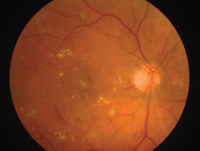 | |
| Diabetic retinopathy does occur in kids.
|
Children who are at greatest risk for diabetic retinopathy are less likely to be screened.1 Despite recommendations for yearly eye exams, only 64% of 1,112 children with type 1 diabetes were screened for retinopathy in the two years they were studied, according to an article in Diabetes Research and Clinical Practice.
Children who were not screened were more likely to be black or have poorer diabetes control.
For optometrists, “the biggest thing we can do is to continue to educate patients and parents on the importance of routine eye care, especially in higher risk populations,” says Jeffry D. Gerson, OD, of WestGlen Eyecare & Omni Eye Centers of Kansas City. “We can also continue to let [diabetes care providers] know about the importance of comprehensive eye care, and that ODs can in fact deliver the care needed.”
Senior author Terri Lipman, PhD, CRNP, of the University of Pennsylvania School of Nursing agrees. She believes if there were more collaborative relationships between diabetes care providers and optometrists, it would improve the chances of patients getting more frequent eye exams and better eye care.
“We want eye care to be part of health care,” Dr. Lipman says. “We want families to become accustomed to yearly eye exams—similar to dental visits—so that if there are some signs of retinopathy, they are caught very early on.”
This is particularly important given the findings of a separate study of retinopathy in children with diabetes, which Dr. Lipman also coauthored. That study found that nearly 14% of young people who had type 2 diabetes for about five years had signs of retinopathy.2
“It’s helpful for ODs to see that even patients who haven’t had diabetes for 20 or 30 years can still have diabetic retinopathy,” Dr. Lipman says. “There was a misperception that diabetic retinopathy only occurred in adults and in those who had diabetes for many years, and this study showed that’s not necessarily the case.”
Of 517 children with type 2 diabetes enrolled in the study, all were overweight or obese and 71 had early signs of retinopathy.
“Results of studies like this are powerful, as 14% is not an insignificant number,” Dr. Gerson says. “It is important to realize that retinopathy often tells us more than just retinal health—it may be a sign of suboptimal glucose control or other systemic diseases that are more likely with presence of retinopathy.”
1. Dumser SM, Ratcliffe SJ, Langdon DR, et al. Racial disparities in screening for diabetic retinopathy in youth with type 1 diabetes. Diabetes Res Clin Pract. 2013 May 1;S0168-8227(13):00087-9.
2. TODAY Study Group. Retinopathy in youth with type 2 diabetes participating in the TODAY clinical trial. Diabetes Care. 2013 Jun;36(6):1772-4.

